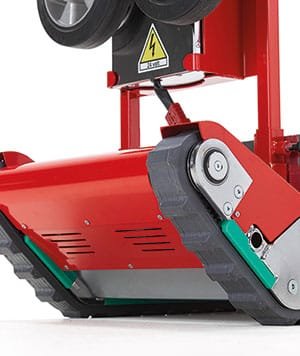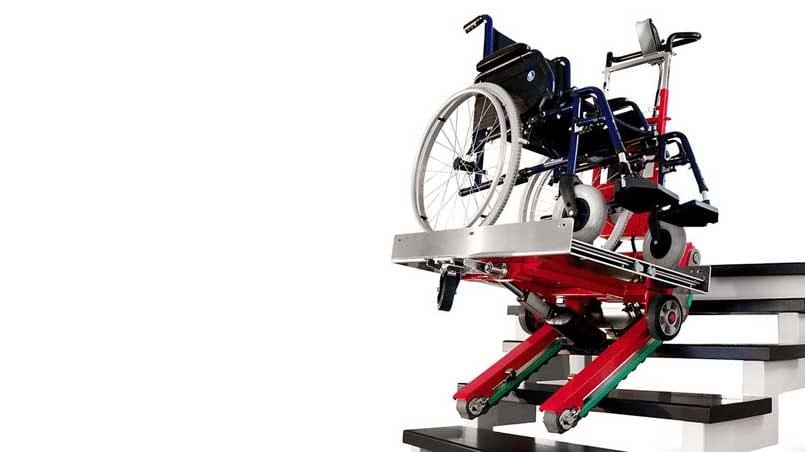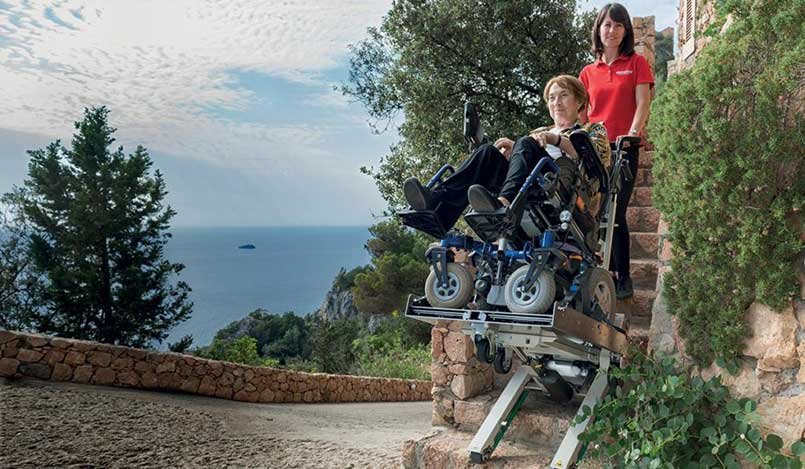Electric stair climbers are dollies for stairs fitted with electric motors that provide greater load capacity than manual stair climbing dollies.
Compared with manual stair climbers, like stair trollies, electric stair climbers also ensure greater safety when carrying loads on stairs. The weight of the load is not manouevred on the stairs using physical strength, but by the electric motor. Motorized stair climbers are fitted with a battery that needs to be kept charged in order for them to operate.
There are two types of electric stair climbers:
- Stair climbers for goods
- Stair climbers for disabled people in a wheelchair
Powered stair climbers for carrying disabled people – which may be fixed or mobile – are either:
- Stair climbers that transport wheelchairs
- Stair climbers for disabled and elderly people that however cannot carry wheelchairs
Electric stair climbing dollies for goods can also be divided into two categories:
- Motorized stair climbers for carrying light goods
- Motorized stair climbers for carrying heavy goods
How do we distinguish between “light” and “heavy” goods? The difference is an important one. When handling goods on stairs, light goods mean those weighing less than 100 kg, and heavy goods those weighing more than 100 kg.
Obviously this does not mean that it is simple, or requires little effort, to move goods weighing 100 kg on stairs. In fact the ISO standard sets a limit of 25 kg on the manual transport of loads, including on stairs.
However, motorized stair climbers can have a very high load capacity, of up to 600 kg. This is why goods are only considered to be “heavy” when they weigh more than 100 kg.
Tracked and Wheeled Electric Stair Climbers
Electric stair climbers for carrying disabled people and electric stair climbing dollies for carrying goods can be divided into two further types:
- Tracked stair climbers
- Wheeled stair climbers

Powered stair climbers with tracks do not travel “step by step” like stair climbers with wheels. When carrying loads with tracked stair climbers, the load is distributed over several steps.
There are structural differences in the technology. Basically, electric stair climbers with tracks have a greater load capacity (up to 600 kg), and are far more suited to carrying heavy loads on stairs. Moreover, tracked stair climbers provide more safety on stairs, whether carrying people with motor difficulties, disabled or elderly people, or transporting goods.

On the other hand, electric stair climbers with wheels are normally more economical than tracked stair climbers, and can also be used on spiral staircases, as they are more compact than stair climbers with tracks.
However, with electric stair climbing dollies, the operator is responsible for ensuring the load is balanced when moving up or down stairs, because the movement takes place “step by step”.
This is the reason wheeled stair climbers are not suitable for moving loads of more than 100 kg on stairs, because they are less safe. Read this article to find out more about the differences between tracked and wheeled stair climbers.
>>Read the article: Stair climber hand truck: which ist best, tracks or wheels?
Electric Stair Climbers for Carrying Disabled People in Wheelchairs

There are motorized stair climbers with wheels or with tracks for carrying people with motor difficulties, disabled or elderly people on stairs.
The same principle applies as above, as the technology for moving up and down stairs is the same as for carrying goods: wheelchair stair crawlers are safer than wheeled stair climbers.
Tracked stair climbers for disabled people have a higher load capacity than those with wheels. They are also more stable, as the weight is distributed over several steps.
Wheeled stair climbers require physical effort on the part of the care assistant, who has to keep the stair climber and the disabled person balanced while moving them on the stairs. This is not the case with tracked stair climbers for disabled people.
There are two additioanl factors to consider:
- Not all powered stair climbers with wheels can carry wheelchairs too
- Moving disabled people who use disabled scooters and electric wheelchairs requires the electric stair climber to have a greater load capacity, as the total load can be in excess of 250 kg
Choosing a motorized stair climber for disabled people therefore requires more care than choosing a motorized dolly for goods. The difference is that it is a person with a disability or motor problems being moved, not an object.
A person in a wheelchair must never fall on the stairs while being moved. The risk of falling is far greater when using stair climbers with wheels than when using stair climbers with tracks. It is therefore advisable to use an electric stair climber with tracks.
>> Read this article to find out more about the stair climbers for disabled people
How many Motors does an Electric Stair Climber have?
The majority of powered stair climbers, whether for carrying disabled people or for goods, only have a single electric motor.
The more modern and technologically advanced motorized stair climbers – like Domino stair climbers by Zonzini – instead have two motors. Each track is in fact powered by an independent motor in order to allow the full rotation (up to 360 degrees) of the passenger or goods in the stairwell.
WHAT IS THE LOAD CAPACITY OF AN POWERED STAIR CLIMBER?
There are many different models of powered stair climbers on the market. The capacity of an electric stair climber with tracks is normally up to a maximum of 150 kg, while motorized stair climbers with tracks can have a capacity of up to 600 kg.
AUTONOMY OF ELECTRIC STAIR CLIMBERS
The autonomy of electric stair climbing dollies and electric stair climbers (for carrying people in wheelchairs) is guaranteed by special gel lead-acid batteries.
Depending on the type of use and the stairs themselves, battery autonomy ranges from 2 to 3 hours, after which the device needs recharging.
Tracked motorized stair climbers and dollies for stairs generally have more high-performance batteries than those with wheels, as they require more electricity to operate. On the other hand, wheeled electric stair climbers are slightly faster.
It is always advisable to have a second battery to hand to replace the one in use when it runs out, in order to increase the autonomy of powered stair climbers.
HOW FAST ARE ELECTRIC STAIR CLIMBING DOLLIES?
A wheeled electric stair climbing dolly for moving light loads may travel approximately up or down 30 steps a minute, while a tracked stair climber for heavy loads (up to 400 kg) travels up or down approximately 15 steps a minute.
The average number of steps between floors is 17, which means that the time needed to travel up a flight of stairs to reach the next floor is approximately 30 seconds.
Electric stair climbers with wheels are normally faster than those with tracks, and this also applies to electric stair climbers for disabled people.
However, speed is only one factor to take into account when moving light loads on stairs, weighing less than 100 kg. An example would be moving a washing-machine or a refrigerator on stairs.
When the weight of the load is greater than 100 kg, the stability – and therefore the safety – of the load becomes a far more important factor than speed.
Moreover, the speed of travel on stairs is normally inversely proportional to the load capacity of the motorized stair climber.
For example, if we take the speed of travel on stairs of the Zonzini motorized wheelchair stair climbers, Domino People and Domino People Slim:
- Domino People has a capacity of 400 kg and travels at 4 metres a minute
- Domino People Slim (portable) has a capacity of 160 kg and travels at 6 metres a minute
The same applies to our wheeled stair climbers Buddy and Buddy Lift and tracked stair climbers (Skipper and Domino).
The greater the load capacity of the stair climber, the slower the speed of travel on stairs.
Electric Innovation of Zonzini’s Domino Electric Stair Climbers
Our Domino range of stair climbing dollies (for goods) and stair climbers (for disabled people) not only have two electric motors, they also use highly innovative technology.
These stair climbers have two main strengths compared with traditional electric stair climbers:
- The load tilt, whether goods or a wheelchair for the disabled, can be either fully automatic or manually regulated
- The speed of travel up and down stairs may be set automatically or manually

In addition, our electric stair climbers with tracks allow a change of direction when travelling up or down stairs, unlike stair climbers that may cost more, but are less advanced and safe, and only travel in one direction.
Do you have any questions about electric stair climbers? Please get in touch and we will be happy to help you make your choice. For two generations, Zonzini has been designing and building electric stair climbers that are now sold all over the world.